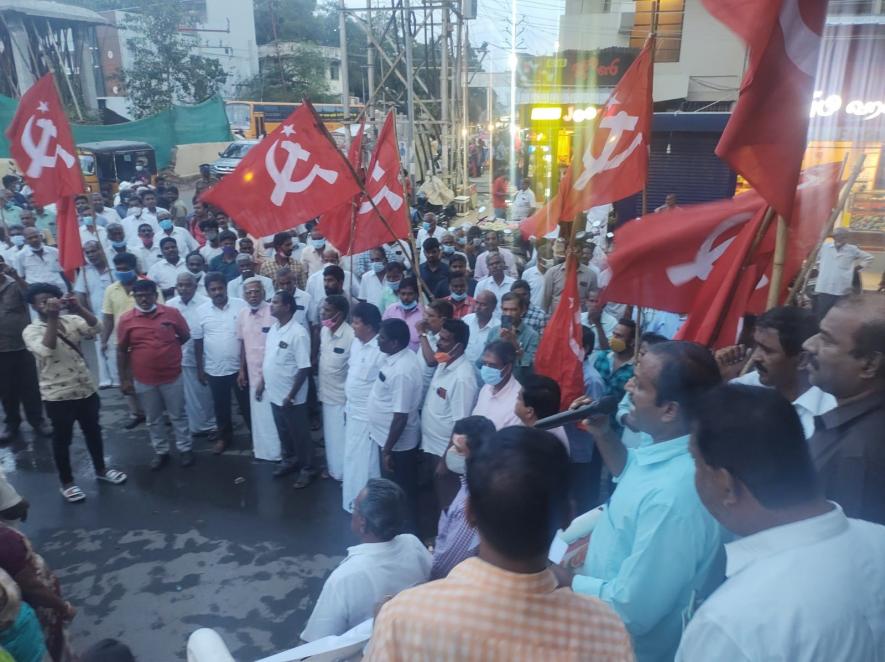US Ban on Chinese Cotton Damages Garment Industry in Western Tamil Nadu

Image courtesy: CITU, Tiruppur
Tiruppur: Small-time garment factory owners and their employees held a protest in the city on November 19 condemning the skyrocketing cotton yarn prices and the indifference of the union government to contain the situation.
The price rise is a direct result of the ban imposed by the United States of America on cotton produced in China, and the pro-US stance of India.
There has been an over 50% increase in cotton prices since the beginning of 2021, and this has steadily slumped the famous readymade garment industry belt in the Tiruppur district.
Garment manufacturers in Tirrupur and the neighbouring districts are worried that this situation could wipe out the entire small-scale garment manufacturing belt in Western Tamil Nadu. There are over 10,000 garment manufacturing industries in Tirrupur alone, which provides employment to over 6 lakh people.
WHY THE PRICE RISE?
A third of the world’s textiles and clothing comes from China, and 87% of China’s total cotton output comes from the single province of Xinjiang. The province produces one-fifth of cotton sold in the international market.
The US has imposed a ban on the purchase of raw cotton and cotton yarn from China, and other developed nations have extended their support. This has created a vacuum for cotton in international trade and the yarn prices have shot up.
An outright ban of cotton from China has created a massive demand for cotton produced in India at the international market and has jacked up the price of cotton lint produced in India. Cotton produced in India is now exported outside the country and hoarded by big manufacturers, and has left the local manufacturers to suffer.
B Nandagopal, a CITU leader from Tirrupur said, “Last November the price of cotton was Rs 220 per kg for 30 counts of combed cotton yarn. After increasing Rs 10 per month, it reached up to Rs 250 per kg by February 2021. It has now touched Rs 340 per kg”.
On November 1, on a single day, the price of cotton spiked by Rs 50. Manufacturers note that such a spike is unprecedented in the history of the industry.
He further said that “Given that the Cotton Corporation of India (CCI) has stopped procuring cotton, big corporations have purchased large quantities and are hoarding. This is creating a further spike in cotton prices. It is impossible for small scale garment manufacturers like us to purchase cotton from them, we will surely run out of business”.
‘INDIAN GOVT MUST INTERVENE’
The protest held on November 19 in Tirrupur was led by the Communist Party of India (Marxist) and a number of trade unions participated in the dharna. They demanded that the Union government mitigate the stagnation in production created by the yarn price hike.
Besides the Centre of Indian Trade Unions (CITU), All India Trade Union Congress (AITUC), Indian National Trade Union Centre, Dravida Munnetra Kazhagam’s Labour Progressive Federation (LPF), Hind Mazdoor Sabha and others united in the protest.
CPI(M) state committee member Kamaraj, who was presiding over the protest said “this is an unprecedented price rise, and only one or two big manufacturers can sustain this situation. Thousands of small-scale mill owners would not be able to carry on at this rate, and would run out of business affecting the livelihood of lakhs of workers”.
Criticising the Bharatiya Janata Party led government at the Centre he said “it is unfortunate that the central government, that must intervene and stand by the small-scale manufacturers, is being a mute spectator in support of the US”.
What upsets the garment industry is that this is an artificially created hike, and can be avoided by channelling the native produce of cotton to the garment industry within India.
“CCI knows what the demand for cotton within India is, they should procure that amount from the farmers and allow only the surplus cotton to be sent for export,” said Nandagopal.
‘GOVT WILL NOT INTERVENE’
Piyush Goyal, Union Minister of Textiles and Commerce & Industry who spoke to textile industry stakeholders at a meeting on November 19, has asked the industry leaders to not force the Government to intervene in the price rise.
Although a ban on cotton exports or imposing stock limits could contain the price rise, the Minister has urged the industry to resolve the issue over high cotton and yarn prices through a spirit of “collaboration rather than competition”.
Too much dependence on state support is not healthy for the robust growth of the sector, Goyal said. “Let free and fair market forces play out,” he said.
As per the Confederation of Indian Textiles Industry (CITI), the apex body for the textile industry in the country said that while cotton prices have surged by 80% to 120% since October last year, yarn prices have increased between 38% and 58% only.
Get the latest reports & analysis with people's perspective on Protests, movements & deep analytical videos, discussions of the current affairs in your Telegram app. Subscribe to NewsClick's Telegram channel & get Real-Time updates on stories, as they get published on our website.
























